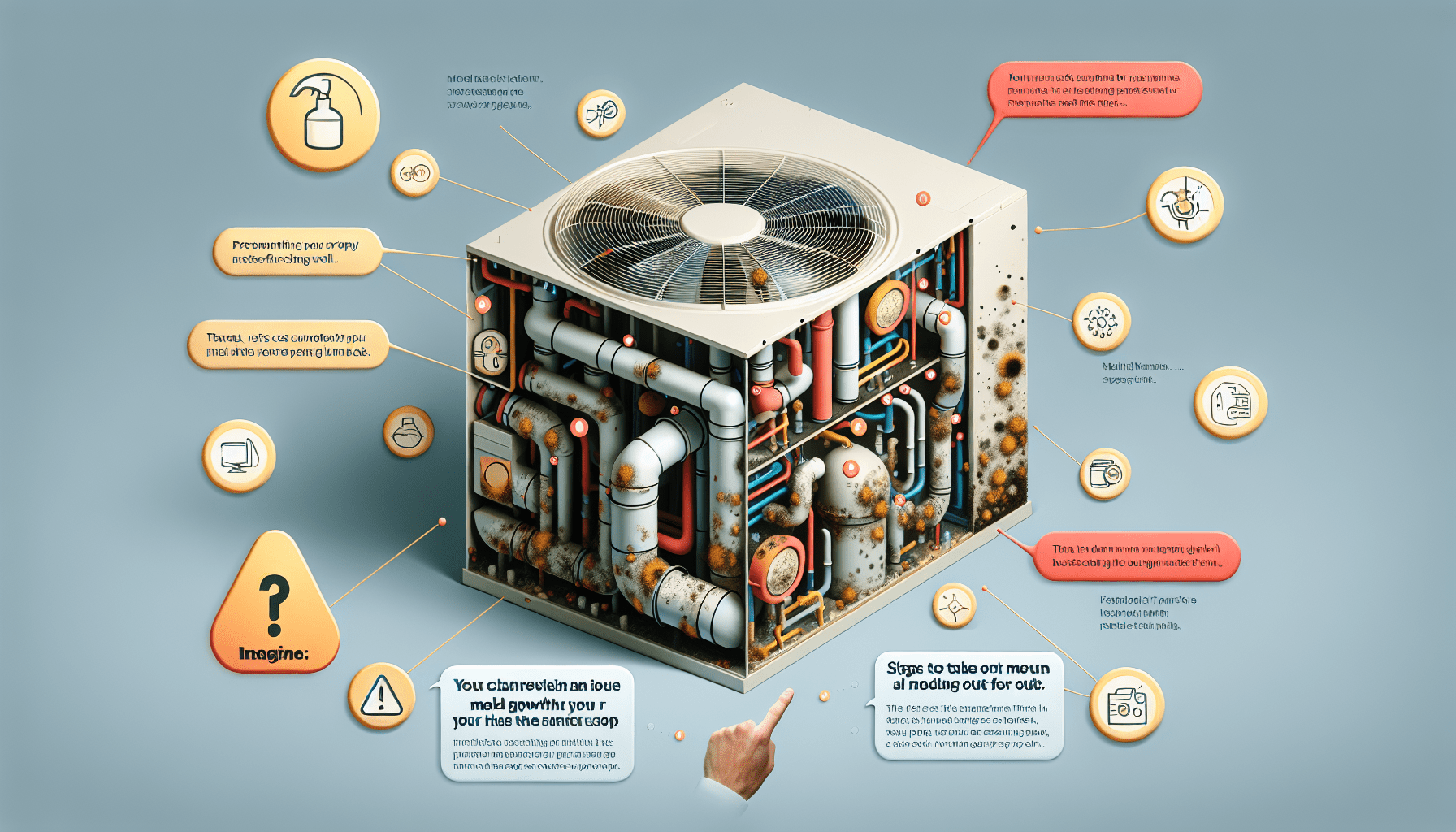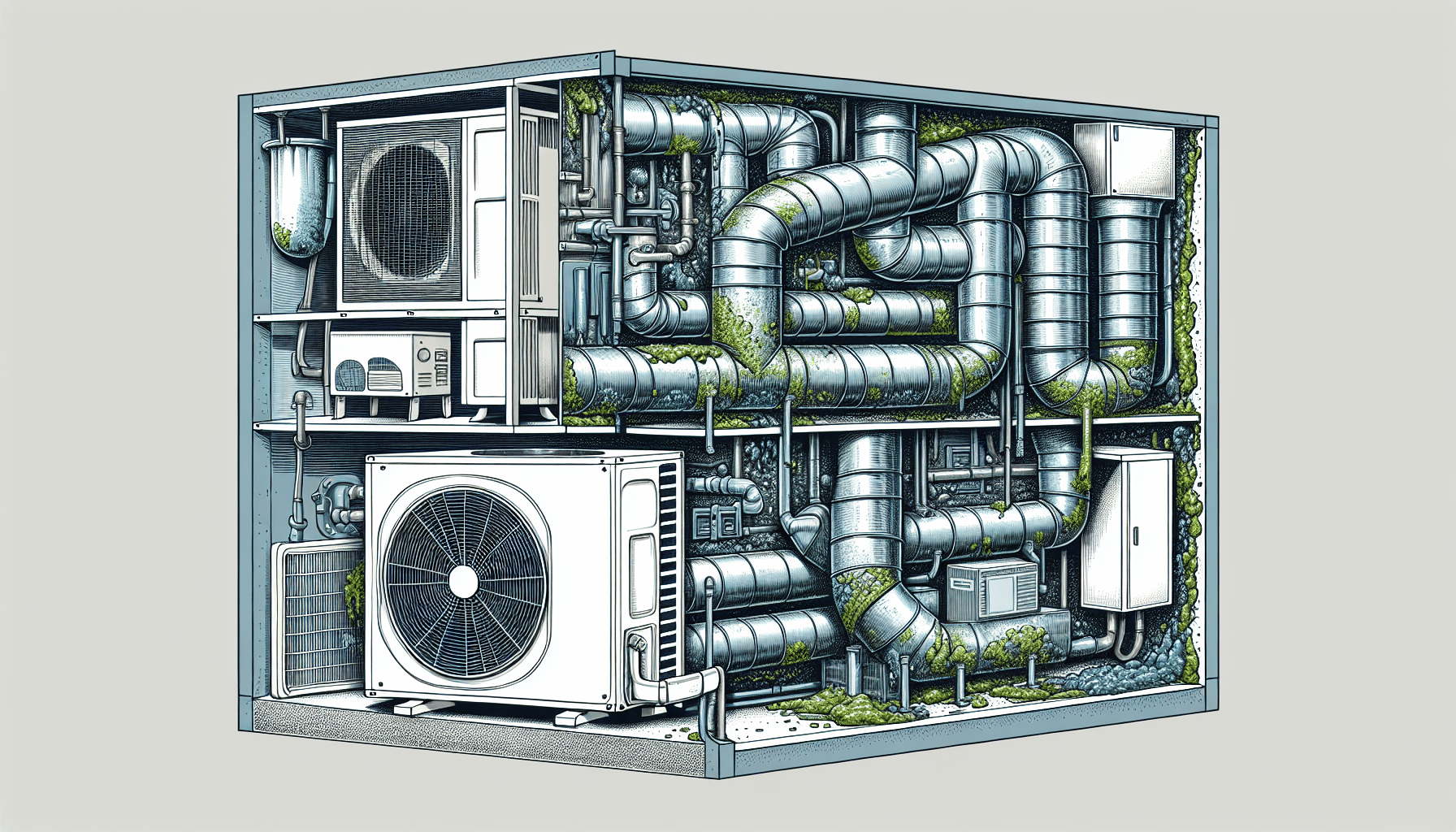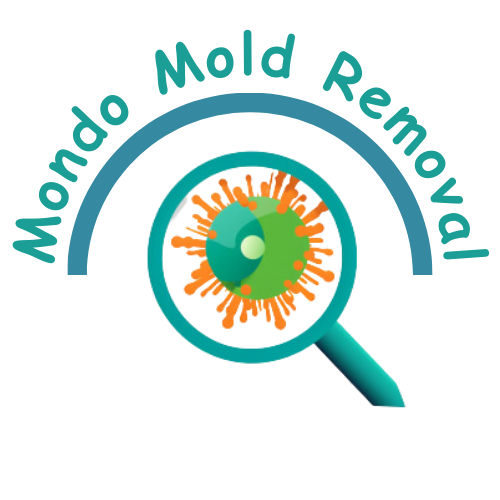Is Your HVAC System Causing Mold Growth? If you’ve been noticing the presence of mold in your home, it’s essential to consider the potential culprit behind its growth – your HVAC system. Mold growth can be triggered by a variety of factors, including excessive moisture, poor ventilation, and even a poorly maintained HVAC system. In this article, we will explore how your HVAC system could be contributing to mold growth and provide essential tips for preventing its occurrence. Don’t let mold take over your home; let’s dive into the details and discover how your HVAC system may be involved.

Understanding Mold Growth in HVAC Systems
Mold is a type of fungus that can grow and spread in various environments, including HVAC (Heating, Ventilation, and Air Conditioning) systems. It thrives in damp, dark, and humid conditions, making HVAC systems an ideal breeding ground for mold growth.
What is mold?
Mold is a common type of fungus that reproduces by producing tiny spores. These spores, which are so small that they cannot be seen by the naked eye, can easily become airborne and spread throughout the environment. Mold can grow on various surfaces, including walls, ceilings, carpets, and even within HVAC systems.
How does mold grow in HVAC systems?
HVAC systems provide the perfect conditions for mold growth. As air circulates through the system, it carries moisture, dust, and other particles. If moisture builds up in the system due to condensation or leaks, the combination of organic matter and moisture creates an ideal environment for mold to grow. Mold can spread throughout the ductwork and other components of the HVAC system, leading to widespread contamination.
Why is mold growth in HVAC systems a problem?
Mold growth in HVAC systems can cause a range of issues for both the system itself and the occupants of the building. Firstly, it can deteriorate the air quality within the building. Mold spores can become airborne and circulate throughout the space, potentially triggering allergic reactions and respiratory problems in individuals. Moreover, the presence of mold can negatively impact the efficiency and performance of the HVAC system, leading to higher energy consumption and increased costs.
Signs of Mold Growth in HVAC Systems
Identifying signs of mold growth in HVAC systems is crucial to address the issue promptly and prevent further problems.
Visible mold growth
The most obvious sign of mold growth in HVAC systems is the presence of visible mold. This can manifest as patches of green, black, or brown growth on the surfaces of the HVAC components or inside the ductwork. If you notice any visible mold, it is important to take immediate action to prevent further contamination and potential health risks.
Musty odor
Another common sign of mold growth in HVAC systems is a persistent musty odor. If you notice an unpleasant smell when the HVAC system is running, it may indicate the presence of mold. Mold releases volatile organic compounds (VOCs) that can create a distinct, earthy odor. If the smell persists, it’s important to have your HVAC system inspected for mold growth.
Respiratory issues
Mold spores can irritate the respiratory system and trigger allergic reactions in some individuals. If you or your family members experience unexplained coughing, sneezing, watery eyes, or a worsening of asthma symptoms, it may be a sign of mold growth in your HVAC system. Pay attention to any respiratory issues that arise when the HVAC system is running, as it may indicate that mold spores are being circulated throughout the building.
Causes of Mold Growth in HVAC Systems
Understanding the causes of mold growth in HVAC systems can help you take proactive measures to prevent it.
High humidity levels
High humidity levels provide the perfect breeding ground for mold. When the air circulating through the HVAC system has excessive moisture, it can lead to condensation and promote mold growth. This can occur when the HVAC system is not properly sized for the space it serves or when the indoor environment does not have adequate humidity control measures in place.
Moisture build-up
Moisture build-up can occur in HVAC systems due to various factors. For example, if there are leaks in the ductwork or the system has not been properly insulated, moisture can enter the system and create conditions conducive to mold growth. Additionally, if the system is not regularly cleaned and maintained, dust and debris can cause blockages and trap moisture, providing a breeding ground for mold.
Poor ventilation
A lack of proper ventilation can contribute to mold growth in HVAC systems. Insufficient airflow and inadequate air exchanges can lead to stagnant conditions where moisture levels can rise. Without fresh air being introduced into the system and stagnant air being properly circulated, mold spores can settle and multiply within the HVAC components and ductwork.
Leaking ductwork
Leaking ductwork can introduce moisture into the HVAC system, leading to mold growth. If there are gaps or cracks in the ductwork, condensation from the air conditioning or heating process can seep into the system. Additionally, if the ductwork is not properly insulated, temperature differentials can cause condensation, further exacerbating the problem. Regular inspection and maintenance of the ductwork are essential to prevent leaks and subsequent mold growth.
Effects of Mold Growth in HVAC Systems
The presence of mold in HVAC systems can have detrimental effects on both the air quality and the overall functioning of the system.
Deterioration of air quality
Mold releases spores that can become airborne and circulate throughout the building. When these spores are inhaled, they can trigger allergic reactions, respiratory issues, and other health problems. The presence of mold in the HVAC system can worsen indoor air quality, causing discomfort and potential health risks for the occupants.
Health risks
Exposure to mold can have various health risks, particularly for individuals with allergies, asthma, or weakened immune systems. Symptoms of mold exposure can range from mild, such as sneezing and coughing, to more severe, including asthma attacks and respiratory infections. The longer individuals are exposed to mold, the greater the potential for long-term health complications.
Decreased HVAC system efficiency
Mold growth can hinder the performance and efficiency of HVAC systems. Mold can accumulate on components, such as coils and filters, reducing airflow and causing the system to work harder to maintain the desired temperature. This not only increases energy consumption but also leads to decreased cooling or heating capacity. Ultimately, the system may become less effective at maintaining a comfortable indoor environment, resulting in occupant dissatisfaction and higher utility bills.

Preventing Mold Growth in HVAC Systems
Taking preventative measures is essential to avoid mold growth in HVAC systems. By implementing the following strategies, you can maintain a healthy and efficient system.
Regular HVAC maintenance
Regular maintenance is key to preventing mold growth in HVAC systems. Schedule professional inspections and cleanings at least annually, ensuring that all components, including coils, filters, and ductwork, are thoroughly cleaned. Routine maintenance helps identify and address any issues that may contribute to mold growth, such as leaks or poor ventilation.
Control humidity levels
Monitoring and controlling humidity levels is crucial in preventing mold growth. Keep humidity levels below 60% to inhibit mold growth. Use dehumidifiers in areas where humidity tends to be high, such as basements or laundry rooms. Consider installing a whole-house dehumidifier to maintain optimal humidity levels throughout the building.
Ensure proper ventilation
Proper ventilation is key in preventing mold growth. Ensure that your HVAC system is appropriately sized for the space it serves, allowing for adequate airflow. Consider installing fans and ventilation systems to improve air exchanges and reduce the potential for stagnant conditions that promote mold growth.
Fix any leaks or water damage
Promptly addressing any leaks or water damage is vital in preventing mold growth. Regularly inspect the HVAC system, including the ductwork, for any signs of leakage or water infiltration. Repair any leaks promptly and ensure that the system is properly insulated to prevent future moisture issues.
Use air purifiers and filters
Air purifiers and filters can help improve indoor air quality and prevent the circulation of mold spores. Choose high-quality filters that are designed to capture mold spores and other allergens. Consider using HEPA (High-Efficiency Particulate Air) filters, which are highly effective in removing airborne particles.
Cleaning and Remediation of Mold in HVAC Systems
If mold growth is detected in your HVAC system, it is crucial to address the issue promptly and thoroughly to prevent further contamination.
Identifying the extent of mold contamination
Determine the extent of the mold growth in your HVAC system. This may require a thorough inspection by a certified mold inspector who can assess the severity of the contamination and provide recommendations for remediation.
Hiring professional mold remediation experts
It is highly recommended to hire professional mold remediation experts to safely and effectively remove mold from your HVAC system. These experts have the necessary knowledge, experience, and equipment to handle the remediation process properly, ensuring that all mold is completely eliminated and that the system is restored to a healthy condition.
Thorough cleaning of HVAC components and ductwork
Professional mold remediation involves a comprehensive cleaning of all affected HVAC components and ductwork. This may include the use of specialized equipment and cleaning agents to remove mold spores and prevent their regrowth. Thoroughly cleaning the system is essential to prevent further contamination and to restore optimal air quality.
Implementing preventive measures to avoid future mold growth
After the mold remediation process, it is crucial to implement preventive measures to avoid future mold growth in your HVAC system. This may include regular inspections, maintenance, and following the preventative strategies mentioned earlier, such as controlling humidity levels and ensuring proper ventilation.
Importance of HVAC Maintenance
Regular HVAC maintenance plays a vital role in preventing mold growth and ensuring the overall performance and longevity of the system.
Regular inspection and cleaning
Scheduling regular inspections and cleanings by HVAC professionals is crucial in identifying and addressing potential issues that can contribute to mold growth. These professionals can assess the system, clean components, and conduct necessary repairs to ensure optimal performance and prevent mold-related problems.
Replacing filters
Regularly replacing filters is essential in maintaining air quality and preventing mold growth. Filters can become clogged with dust, debris, and mold spores, hindering airflow and creating conditions for mold growth. Follow the manufacturer’s recommendations for filter replacement intervals and consider using high-quality filters designed to capture mold spores.
Sealing ductwork
Properly sealing ductwork is a key preventive measure against mold growth. Leaky ducts can introduce moisture into the HVAC system, leading to mold growth. Have a professional inspect the ductwork regularly, identify any leaks, and seal them using appropriate materials. This will help maintain good airflow and prevent moisture infiltration.
Monitoring humidity levels
Regularly monitoring and maintaining humidity levels within the recommended range is vital in preventing mold growth. Utilize humidity monitors or a smart thermostat to keep track of humidity levels. If levels exceed the recommended range, take appropriate measures such as using dehumidifiers or ventilation systems to maintain optimal conditions.
Common Mistakes to Avoid
Avoiding these common mistakes can help prevent mold growth in HVAC systems and maintain a healthy indoor environment.
Neglecting HVAC maintenance
Neglecting regular HVAC maintenance can contribute to mold growth. Without routine inspections, cleanings, and necessary repairs, issues such as leaks, poor ventilation, or debris accumulation can go unnoticed, creating conditions that promote mold growth. Regular maintenance is essential in preventing these issues and maintaining a healthy system.
Ignoring signs of mold growth
Ignoring signs of mold growth can lead to further contamination and potential health risks. If you notice visible mold, musty odors, or respiratory issues when your HVAC system is running, do not ignore them. Promptly address the issue by seeking professional assistance to ensure that mold is properly remediated and the system is restored to a healthy condition.
Using ineffective cleaning methods
Attempting to clean mold growth in HVAC systems using ineffective methods can lead to incomplete removal and subsequent regrowth. DIY cleaning methods may not properly eliminate mold spores or address underlying issues, such as leaks or poor ventilation. It is crucial to seek professional assistance and rely on their expertise and specialized equipment to ensure thorough cleaning and remediation.
Professional Assistance for HVAC and Mold Issues
When dealing with HVAC and mold issues, seeking professional assistance is recommended to ensure proper remediation and maintenance.
Consulting HVAC technicians
Experienced HVAC technicians can provide valuable insights into preventing mold growth in your HVAC system. They can conduct regular inspections, cleanings, and necessary repairs to maintain the system’s performance and prevent mold-related problems. Consult with HVAC technicians for guidance and professional maintenance services.
Hiring certified mold inspectors
Certified mold inspectors have the expertise to assess the extent of mold contamination and provide comprehensive recommendations for remediation. They can identify the underlying causes of mold growth in your HVAC system and ensure that all affected areas are properly addressed. Hiring certified mold inspectors is essential for accurate assessments and effective remediation.
Seeking professional mold remediation services
Professional mold remediation services can safely and effectively eliminate mold growth from your HVAC system. These experts utilize specialized equipment, follow industry guidelines, and have the experience to properly address mold contamination. Hiring professional mold remediation services ensures that mold is thoroughly removed, the system is restored to a healthy condition, and preventive measures are implemented.
Conclusion
Understanding mold growth in HVAC systems is key to preventing its occurrence and addressing any existing issues promptly. By being aware of the signs, causes, and effects of mold growth, as well as implementing preventative measures, regular maintenance, and seeking professional assistance when needed, you can maintain a healthy and efficient HVAC system. Remember, proactive measures and timely remediation are essential in preventing mold-related problems and ensuring the well-being of both your HVAC system and the occupants of your building.






